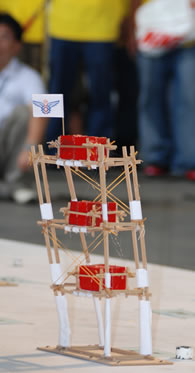

The Shaking-table TestsIn the final competition, models will be tested on a shaking-table for a series of earthquakes. The first earthquake will be very small. Then the size of the earthquakes will be increased gradually up to the maximum that the shaking-table can produce. The Most-Efficient ModelFor every model, a record will be made of its imaginary cost and the size of the earthquake that causes it to fail. An efficiency ratio for your model will be calculated as:
The team with the model that has the highest efficiency ratio will win the prize for the "Most Efficient Model". Failure criteria for ModelsDuring the shaking-table tests, a model will be judged to have failed for any of the following conditions:
Note: The judges' decision is final. |
 |
